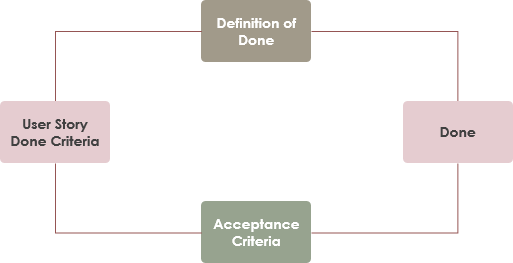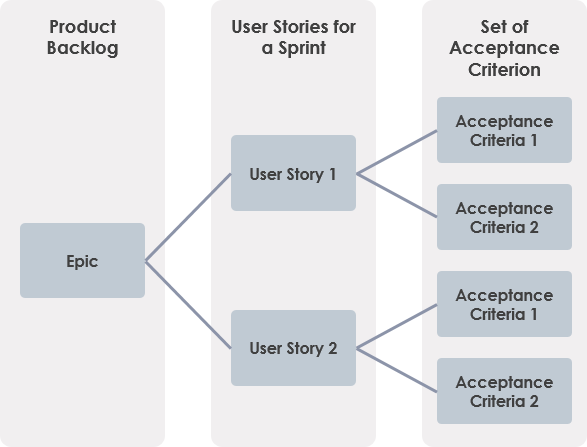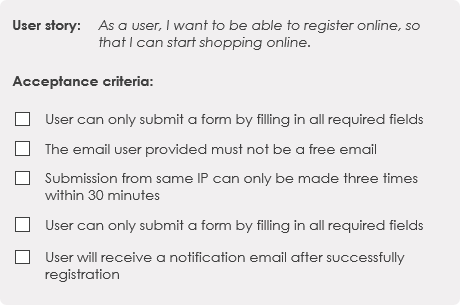Definisi Selesai (DoD)adalah daftar persyaratan yang harus dipatuhi oleh user story agar tim dapat menyebutnya selesai. SementaraAcceptance Criteriadari User Story terdiri dari serangkaian Skenario Uji yang harus dipenuhi untuk mengonfirmasi bahwa perangkat lunak berfungsi seperti yang diharapkan.
Perbedaan antara keduanya adalah bahwaDoD berlaku umum untuk semua User Stories sedangkan Acceptance Criteria berlaku untuk User Story tertentu.. Acceptance Criteria dari setiap User Story akan berbeda berdasarkan persyaratan User Story tersebut.
Dengan kata lain,Baik DoD maupun Acceptance Criteria harus dipenuhi untuk menyelesaikan User Story.Increment Produk tidak dianggap selesai, kecuali kedua daftar ini telah selesai. Oleh karena itu, kita perlu mendefinisikan dua aspek dari Definisi Selesai (DOD) – Kriteria Penyelesaian dan Acceptance Criteria:

Definisi Selesai
Definisi Selesai disusun sebagai daftar item, masing-masing digunakan untuk memvalidasi sebuah Story atau PBI, yang ada untuk memastikan bahwaTim Pengembangansetuju tentang kualitas pekerjaan yang mereka coba hasilkan. Ini berfungsi sebagai daftar periksa yang digunakan untuk memeriksasetiap Product BacklogItem (alias PBI) atau User Story untuk kelengkapan. Item dalam definisi ‘Selesai’ dimaksudkan untuk berlaku untuk semua item dalam Product Backlog, bukan hanya satuUser Story. Ini dapat dirangkum sebagai berikut:
- Istilah ini lebih berlaku untuk peningkatan produk secara keseluruhan
- Dalam banyak kasus, istilah ini menyiratkan bahwa peningkatan produk adalahsiap kirim
- Istilah ini didefinisikan dalam Panduan Scrum
- Digunakan sebagai cara untuk berkomunikasi di antara anggota tim
- Kualitas Perangkat Lunak Secara Keseluruhan
- Apakah peningkatan tersebut siap kirim atau tidak
Tujuan dari Definisi Selesai
- Membangun pemahaman bersama dalam Tim tentang Kualitas dan Kelengkapan
- Digunakan sebagai daftar periksa bahwa User Stories (atau PBIs) diperiksa
- Pastikan peningkatan yang dikirim di akhirSprintmemiliki kualitas tinggi dan bahwa kualitas tersebut dipahami dengan baik oleh semua yang terlibat.
Contoh — Definisi Selesai
Sebagai contoh, dalam industri perangkat lunak, tim mungkin perlu mengajukan beberapa pertanyaan berikut untuk merumuskan DoD mereka:
- Kode telah ditinjau oleh rekan?
- Kode telah selesai?
- Kode telah ditinjau?
- Kode telah di-check-in?
- Uji unit lulus?
- Uji fungsional lulus?
- Uji penerimaan selesai?
- Pemilik Produktelah ditinjau dan diterima?
Acceptance Criteria
User stories adalah salah satu artefak pengembangan utamaartefakuntukpengembangan Agile, tetapi Scrum tidak secara eksplisit mengharuskan penggunaan User Stories atau Acceptance Criteria. Jika sebuah item backlog produk dianggap terlalu besar untuk dimasukkan ke dalam sprint, biasanya akan dipecah menjadi user story dan selanjutnya menjadi serangkaian tugas seperti yang ditunjukkan pada Gambar:

User Stories menggabungkan Acceptance Criteria, sehingga kita sering melihat definisi selesai dan kriteria penerimaan yang ada bersamaan dalam proses pengembangan scrum kita. User story memberikan konteks dari fungsionalitas yang harus disampaikan tim. Kriteria penerimaan memberikan panduan tentang rincian fungsionalitas tersebut dan bagaimana pelanggan akan menerimanya. Keduanya bersama-sama memberikan keseluruhan hasil yang dapat disampaikan.
Beberapa Kriteria Penerimaan akan ditemukan dalam acara Penyempurnaan Backlog yang Berlangsung sebelum Sprint dimulai, dan yang lainnya akan ditemukan segera setelah Perencanaan Sprint ketika duduk untuk berbicara tentang user story dalam tim kecil. Jadi Kriteria Penerimaan adalah atribut yang unik untuk User Story atau Item Backlog Produk.
- Istilah ini berlaku untuk PBI/Story individu
- Kriteria Penerimaan berbeda untuk setiap PBI/Story
- Istilah ini tidak didefinisikan dalam Panduan Scrum
- Digunakan sebagai cara untuk mengkomunikasikan kepada semua yang terlibat bahwa persyaratan untuk PBI/story tertentu telah terpenuhi
- Juga dikenal sebagai Uji Penerimaan, Kondisi Kepuasan, dalam beberapa kasus “Kasus Uji,” dll
Tujuan dari Kriteria Penerimaan
- Jelaskan apa yang harus dibangun tim sebelum mereka mulai bekerja
- Pastikan semua orang memiliki pemahaman yang sama tentang masalah
- Bantu anggota tim mengetahui kapan Story selesai
- Bantu memverifikasi Story melalui uji otomatis.
Contoh — Kriteria Penerimaan
- Seorang pengguna tidak dapat mengirimkan formulir tanpa menyelesaikan semua kolom wajib
- Informasi dari formulir disimpan dalam database pendaftaran
- Pembayaran dapat dilakukan melalui kartu kredit
- Email pengakuan dikirim kepada pengguna setelah mengirimkan formulir
Contoh User Story dengan Kriteria Penerimaan
Gambar di bawah ini menunjukkan contoh kriteria penerimaan dari sebuah user story.

Referensi
This post is also available in Deutsch, English, Español, فارسی, Français, 日本語, Polski, Portuguese, Ру́сский, Việt Nam, 简体中文 and 繁體中文.













